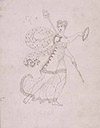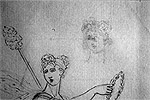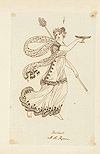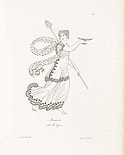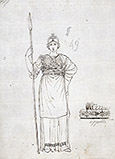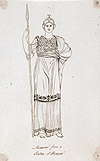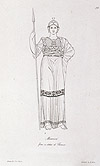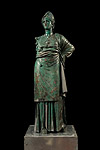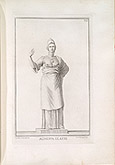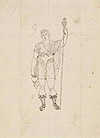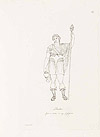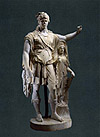The browser will either open the file, download it, or display a dialog.
|
|
|
|||
| Unpublished Drawings by Thomas Hope and Henry Moses in the Gennadius Library, Athens | ||||
|
The Gennadius Library of the American School of Classical Studies in Athens owns two sets of largely unpublished drawings of figures in ancient costumes. The drawings are important because they document the working method of the Neoclassical collector, author, and artist Thomas Hope (1769–1831) in the production of his widely used costume compendium, Costume of the Ancients. All unsigned, the drawings are collected in two albums—one containing 97 sheets, the other 106. Executed in sepia or pen and pencil, they can be dated, along with the albums into which they were pasted, to the early 19th century.1 The first album is entitled, on the spine, “[O]UTLINES FOR MY COSTUME” (hereinafter, “Album 1”), and the second is entitled “COSTUMES OF THE ANCIENTS.—HOPE.” (hereinafter, “Album 2”).2 Both titles clearly refer to Hope’s Costume of the Ancients, which was first published in 1809, with 200 prints; the enlarged second edition, with 300 prints, appeared in 1812. Nearly all the 203 drawings in the two albums have the same figures as, and appear to be preparatory and final studies for, the engravings and etchings in these two editions (e.g., figs. 1–7 and 10–11).3 |
||||
|
This article presents the current state of my research on the two albums of drawings. In the future, I hope to publish a monograph that explores them more fully. The first step was to organize the drawings according to where the same figure appears, both within the two albums, and in the prints from the 1809 and 1812 editions of Costume of the Ancients. The signatures on the prints were also examined, for the information they provide. In many cases, they indicate who did the drawing for the plate, who executed the plate itself, and what kind of print the plate is. The handwriting of the labels on the drawings, which was also studied, suggested that the first album is by Thomas Hope himself, and the second album by more than one other artist. To confirm that the two albums were executed by Hope and additional artists, the artistic styles of the drawings with different handwriting styles were compared, but further work in this last area needs to be carried out. |
||||
|
The results of my research are presented in the chart entitled Comparative Analysis (hereinafter, "CA;" see the end of this article). The CA organizes the drawings into three basic groups. Group A contains all the costumed figures that appear in both Album 1 and Album 2 (e.g., figs. 1–3 and 5–6). Group B includes all the figures in Album 1 that do not reoccur in Album 2 (e.g., fig. 10). Group C is comprised of all the figures from Album 2 that do not appear in Album 1. The drawings fall into smaller subgroups within these three large groupings. The subgroups are based on the signatures on the plates from the 1809 and 1812 editions of Costume of the Ancients that have the same figures as the drawings (e.g., figs. 4, 7 and 11). |
||||
|
Group A of the CA has twenty-three pairs of matching drawings where the same figure appears in both albums. A comparison of the first pair (figs. 1–3) demonstrates the stylistic differences between the two albums. In the Bacchante from Album 1 (fig. 1), the drapery folds have soft, round curves that are quite unlike the straight folds in the skirt of the same figure from Album 2 (fig. 3). Note, too, that the outlines of the Bacchante’s legs are visible through the drapery in the first drawing, while in the second drawing the legs are lost beneath the seemingly heavy, non-transparent drapery. There are also clear differences in the handling of the facial features. In figure 2, the Bacchante’s open lips are defined by single, looping lines. The broader, closed lips of the Bacchante in figure 3 are more carefully defined. The nose of figure 2 is indicated by a single line at its base, while in figure 3, the entire bridge of the nose and one of the nostrils are outlined. A similar, more abbreviated handling of the lips and nose is evident in figure 5 from Album 1, as opposed to the fuller definition in figure 6 from Album 2. Stylistic differences such as these contribute to the looser, more flowing quality of drawings in the first album. In the second album, the figures have a stiffer, more formal treatment. The handwriting and artistic style of the drawings in Album 1 are consistent throughout, indicating that Thomas Hope was the sole artist of these drawings. However, in Album 2, there are nine drawings whose labels are in different handwriting styles from the handwriting on the majority of the drawings. These nine drawings also appear to be stylistically different from the other drawings in Album 2. Thus, stylistic differences, coupled with handwriting styles of the labels, indicate that there were at least three artists—one for Album 1 (Thomas Hope), and two or more for Album 2. These conclusions are in agreement with the signatures on the plates in Costume of the Ancients, where Henry Moses’s name appears most frequently, but the signatures of other engravers occasionally appear as well. |
||||
|
The attribution of the drawings in Album 1 to Thomas Hope himself4 is supported by the resemblance of those drawings to published travel drawings by Hope that are located at the Benaki Museum in Athens.5 Similarities in the treatment of drapery are among the stylistic traits that link the two sets of drawings. For example, the interior folds of the bunched drapery around the waist of Minerva in figure 5 end in loops, a feature that is also evident in Hope’s drawing at the Benaki of a Fragment of a statue at Naxia.6 Also, Hope’s distinctive way of defining the puffy lower lip of the mouth with a single looped line (cf. fig. 2) can be found on many of the faces in the Benaki drawings that are shown from a three-quarter or frontal view. Moreover, the handwriting in both sets of drawings is clearly the same. Hope wrote labels on 38, or over a third of the drawings in Album 1. Only one of these labels is the same as the title on the matching plate in Costume of the Ancients. |
||||
|
Hope executed the drawings at the Benaki Museum during his travels in Greece at the end of the 18th century.7 They are certainly by Hope, because many of them are in two volumes bearing the title on the spine “DRAWINGS BY T. HOPE.” The others are in three other volumes that, like the first two, originated in Thomas Hope’s library.8 As all five volumes were included in Christie’s catalogue of the 1917 sale of the contents of that library, the provenance appears certain. Significantly, the album “[O]UTLINES FOR MY COSTUME” was also listed in that sale’s catalogue.9 That this album formed part of Hope’s library establishes that the “MY” in its title refers to Hope himself. |
||||
|
The attribution of Album 1 to Hope is also supported by plates from Costume of the Ancients that bear Hope’s signature and correspond to some of the drawings in the album. Ten of the drawings have the same figures as plates in both editions of Costume of the Ancients that are signed by Hope as the draughtsman and etcher, and seven more correspond to plates, with the same signature, that appear only in the 1812 edition (CA, Subgroups B4 and B5). Three additional drawings correspond to plates that are signed by Hope as the draughtsman only (CA, Subgroups B6 and B7), and three more correspond to plates signed by Hope as etcher only (CA, Subgroups B8 and B9). |
||||
|
A comparison between one of Hope’s drawings from Album 1 (fig. 10, Subgroup B9) and the corresponding Costume of the Ancients etching (fig. 11) strongly suggests that Hope used such drawings as final models for his prints. Nearly all the details of Bacchus’s pose, costume and attributes are the same in the drawing and etching and both are taken from the same angle. That the figures of Bacchus in the drawing and the etching are the same scale reinforces the supposition that Hope made his own final drawings for his etchings. |
||||
|
At the end of his introduction to the 1812 edition of Costume of the Ancients, Hope explained that the reason why he etched at least some of the plates, such as fig. 11, was that he had had a difficult time finding good outline engravers:
In spite of his stated difficulty finding competent outline engravers, Hope was able to find and employ Henry Moses (ca. 1782–1870), a young engraver whom he described as having “made the engravings from most of my drawings.”11 It was common practice at the time for dilettantes, like Hope, to use professional engravers to reproduce their drawings, and Moses’s role is evidenced by his frequent signature as engraver on the plates from both editions of Costume of the Ancients (see figs. 4 and 7, and the CA, Subgroups A1, A2, B1, B2, C1 and C2). |
||||
|
Signatures on the plates of Costume of the Ancients also support the attribution to Moses of most of the drawings in Album 2. In five instances, plates from the 1809 and 1812 editions that are signed “Drawn & Engraved by H. Moses” match drawings in Album 2 only (CA, Subgroup C1). Since these five drawings are in a different artistic style and exhibit a different handwriting from Hope’s drawings in Album 1, I assumed that they were in fact executed and labeled by Moses. I then compared the handwriting from these drawings with the labels on the rest of the drawings from Album 2. Ninety-nine, or nearly all the 106 drawings in Album 2, have handwritten labels. Only nine of these labels appear to be in a handwriting style different from that of Moses; the drawings on which these labels appear are also in a different artistic style or styles (CA, Subgroups A2, A3, A5, A6, C6, C7 and C8). Judging, then, from the labels, most of the drawings in Album 2 are by Moses.12 |
||||
|
Figures 3 and 6 are among the drawings in Album 2 that can be attributed to Moses. Both closely resemble, and are of the same scale, as engravings from Costume of the Ancients that are signed on the lower right “Engraved by H. Moses” (figs. 4 and 7). Significantly, figures 4 and 7 both bear second signatures on the lower left, “Drawn by Thos. Hope.” The drawings by Hope that these signatures refer to are among those in Album 1 (figs. 1–2 and 5). These two drawings by Hope are not as closely related to the final engravings by Moses as are figures 3 and 6, and seem to have served a different purpose, i.e., that of preliminary studies. Moses would have transformed such preliminary studies into renderings in his own artistic style, such as figures 3 and 6, that survive in Album 2. Moses apparently then used these final renderings as models for his engravings in Costume of the Ancients.13 The fact that his two drawings (figs. 3 and 6) have the same text in the labels as the titles of the matching engravings (figs. 4 and 7) adds further support to this supposition. In fact, of the 99 handwritten labels for the 106 drawings in Album 2, only 24 are not the same as the titles of the matching engravings in Costume of the Ancients.14 |
||||
|
The twenty-three pairs of matching drawings from Albums 1 and 2 break down into several subgroups. Subgroup A1 contains five pairs of drawings, of which figs. 1–3 and 5–6 are illustrative, that correspond to engravings in both the 1809 and 1812 editions of Costume of the Ancients signed by Hope as draughtsman and Moses as engraver (see figs. 4 and 7). Subgroup A2 comprises four pairs of drawings that correspond to similarly signed engravings that only appear in the 1812 edition of Costume of the Ancients. The presence of Moses’s signature on engravings in the 1812 edition alone demonstrates that he continued his professional relationship with Hope beyond the publication of the 1809 edition and up to the publication of the 1812 edition. Subgroups A3 through A6 contain drawings that do not correspond to plates signed by Moses. However, most of the drawings in these subgroups from Album 2 have labels in Moses’s handwriting, which allows many of the matching engravings to be attributed to him. |
||||
|
Seventy-four of the drawings by Hope in Album 1 contain figures that are not found in Album 2 (CA, Group B), and 72 drawings in Album 2 have figures that are not in Album 1 (CA, Group C). However, all of these drawings correspond to plates in the 1809 and/or 1812 editions of Costume of the Ancients. As already indicated above, Hope stated that Moses normally made engravings after his drawings.15 The nine pairs of matching drawings from Albums 1 and 2 that correspond to plates signed by Hope as draughtsman and Moses as engraver suggest that the normal procedure was for Hope to make a preliminary drawing (e.g., figs. 1–2 and 5), and Moses a final drawing (e.g., figs. 3 and 6), which Moses would then use as the model for his engraving (e.g., figs. 4 and 7). That Hope’s drawings from Group B were not necessarily the final drawings that Moses used as the models for his engravings is further suggested by frequent discrepancies in scale between Hope’s drawings and the plates in Costume of the Ancients.16 Thus, it seems likely that in the case of at least some of Hope’s drawings from Group B, corresponding final drawings have been lost. |
||||
|
As Hope stated that Moses normally made engravings after Hope’s drawings, the seventy-two drawings in Album 2 that have no matching drawings in Album 1 (CA, Group C), were probably inspired by preliminary drawings by Hope which have not survived.17 This supposition is verified, at least for some of the drawings in this group, by the signatures on the plates in Costume of the Ancients that correspond to 23 of these drawings (CA, Subgroup C2). Here the plates are signed by Hope as draughtsman and Moses as engraver; since only Moses’ final drawings survive, all with labels in his handwriting, it can be concluded that Hope’s preliminary drawings once existed. Two more drawings from Group C in Album 2 correspond to engravings signed by Hope as draughtsman and R. Roffe as engraver (CA, Subgroup C4). These drawings have labels that appear to be in Moses’ handwriting, but their artistic style seems different from those of both Hope and Moses. Judging from this evidence and the signature of Roffe as engraver, Moses brought in additional engravers who did their own final drawings after Hope’s drawings that Moses then labeled, and who executed and signed their own engravings.18 |
||||
|
Album 2 also contains 11 drawings, some certainly with figures from Greek vases, that do not match engravings from either edition of Costume of the Ancients (CA, Group D). Since four of these drawings have labels in Moses’s handwriting and since they all stylistically resemble the five drawings that can securely be attributed to Moses (CA, Subgroup C1), they can be attributed to him, but their purpose remains unclear.19 |
||||
|
In the introduction to Costume of the Ancients, Hope explained his methods of achieving his costumed figures.20 One method involved using a single antique figure as the main source of inspiration. When this was the case, Hope made reference to the archaeological source in the title, as in figure 10 which corresponds to an etching executed by Hope with the title Bacchus. from a statue in my possession (fig. 11). In both renderings, the god throws most of his weight onto his straight right leg, while resting his raised left arm on his thyrsus. In his lowered right hand is a pitcher, which Bacchus could be understood to be offering, full of wine, to an implied worshipper, the possible focus of his downward gaze. Bacchus wears laced, open-toed boots with panther heads at the tops. On his torso he wears a short chiton, over which a panther skin has been belted. A cloak, suspended from his left arm and draped over his right shoulder, hangs behind his back. The god has long hair that rests on his neck and shoulders, and he wears a grape wreath. |
||||
|
In Hope’s time, the over-life-sized marble statue that his drawing and etching reproduce (fig. 12) was first located in the Statue Gallery in Hope’s Duchess Street house in London, then moved to his country home in Deepdene. In 1917, it was sold to Frances Howard, great-grandson of Benjamin Franklin. In 1990, it reappeared in a Sotheby’s sale in New York, and was purchased by the Metropolitan Museum of Art, where it is now on view in the Leon Levy and Shelby White Court.21 |
||||
|
When the statue is compared with Hope’s drawing and etching, it is immediately apparent that Hope included attributes that are no longer present in the hands of Bacchus—a thyrsus and a pitcher. An engraving of the statue, published by the Comte de Clarac in 1850, shows a pitcher in the god’s lowered right hand and the top of a thyrsus in his raised left hand.22 Thus, we can conclude that Hope was faithful to the statue’s condition in his time when he included both attributes in his drawing and etching. However, as the photograph in the 1917 Christie’s sales catalogue demonstrates, by the time the statue was sold to Frances Howard, the pitcher and thyrsus had been removed.23 |
||||
|
In his renderings of the Bacchus statue, Hope omitted a detail that is still present today—a female idol under the god’s left arm, probably a representation of the goddess Spes (Hope).24 Her omission makes sense in the context of Hope’s intended purpose: to illustrate correctly costumed ancient figure types. He wanted them to serve as models for artists of classical subject matter.25 He may therefore have decided that a generic Bacchus without the idol was more easily transferable to an artist’s canvas. |
||||
|
A second instance in which Hope named his archaeological source is the Minerva from a Statue at Florence, which is known from Hope’s preliminary drawing, Moses’s final drawing, and an engraving in both editions of Costume of the Ancients that is signed by Hope as draughtsman and Moses as engraver (figs. 5–7, CA, Subgroup A1). The figure of Minerva in both drawings (figs. 5–6) has the goddess’s spear and her traditional armor of a helmet and a breastplate called the aegis, which is bordered with snakes and decorated with the fearful head of the Gorgon Medusa.26 Minerva wears her aegis over a chiton. A mantle or himation is wrapped around her waist and hangs down to her knees, as well as being pulled over her left shoulder from the back and wound around her left arm.27 Hope calls the mantle a peplum, evidently confusing it with the woolen gown that archaeologists now call the peplos.28 However, he describes an arrangement of the peplum which is similar to that of the Minerva’s himation. He states that “for the sake of convenience, Diana generally had her’s [sic] furled up and drawn tight over the shoulders and round the waist, so as to form a girdle, with the ends hanging down before or behind.”29 |
||||
|
In Hope’s time, there were two statues of Minerva on view in the Uffizi, one made of bronze (fig. 8a), the other of marble.30 The engraving (fig. 7) follows the bronze Minerva in all major respects except for the raised right arm that holds a spear. Before 1785, the bronze statue had a restored plaster forearm that was raised, as Hope rendered it. However, in 1785 the sculptor Francesco Carradori made the bronze restoration of the right forearm, shown in figure 8a, in which it is held in a horizontal position.31 As Hope is not known to have traveled to the Mediterranean before 178732 he probably derived the raised forearm of the Minerva from a 1734 engraving of the bronze figure, in which the plaster forearm is still in place (fig. 9). The engraving is from volume 3 of a ten-volume corpus by Antonio Francesco Gori, called Museum Florentinum, exhibens insigniora vetustatus monumenta quae Florentiae sunt in thesauro Mediceo, which Hope is known to have owned.33 Today, the bronze right arm of 1785 has been removed, thanks to a recent restoration and reconstruction completed in 2008 (fig. 8b).34 Another possible source for the raised forearm of Hope’s Minerva and her spear is the marble Minerva at the Uffizi. According to this scenario, Hope derived his Minerva from the bronze statue in most respects, but also borrowed elements of the marble Minerva. |
||||
|
A small detail suggests that the engraving from Museum Florentinum (fig. 9) was the more likely source for Hope’s drawing (fig. 5). This is the long piece of the himation that hangs beneath Minerva’s left hand all the way to the goddess’s left foot. The same long piece of drapery is present in fig. 9. However, the drapery in the same position on the bronze statue is handled differently (figs. 8a–8b). Here it is made of two separate garments. The upper portion forms part of the himation and only hangs down below Minerva’s left hand to her knee. The lower portion forms part of the goddess’s chiton and reaches from her knee to the ground. Since the drapery is handled correctly on the bronze statue (figs. 8a–8b) and incorrectly in the engraving in Museum Florentinum (fig. 9), Hope probably derived the erroneous drapery treatment from the engraving. |
||||
|
Hope’s drawing of the statue of Minerva shows how he enhanced the figure by adding ornaments to it. For example, to the right of the figure in his drawing (fig. 5), Hope penned a border of palmettes, inscribing “approved” next to it. In his final drawing (fig. 6), Moses positioned the palmette pattern on the base of the himation. In Costume of the Ancients, Hope explains that he customarily added bands of patterns to his costumed figures because he believed that ancient drapery was more colorful and more ornate in its patterns than a cursory examination of ancient statuary seems to indicate:
Significantly, Hope’s views regarding the bright colors and intricate patterns of ancient drapery have been validated by recent studies of surviving pigment traces on Greek marble statuary. Furthermore, information has been gleaned from colored renderings made immediately after the discovery of ancient marble statues, when their painted decorations were still well-preserved.36 |
||||
|
Hope’s second method of designing his figures involved “combining in a single figure the representations of articles collected from many different originals.”37 When Hope used multiple archaeological sources, he gave his figures generic titles such as Bacchante with the thyrsus (figs. 1–4, from CA, Subgroup A1). The Bacchante in Hope’s drawing (figs. 1–2)38 is apparently such a pastiche. The graceful devotee of Bacchus strides rapidly from left to right, turning her head to look over her shoulder. Her thin veil and skirt billow out behind her. The drawing shows stylistic similarities to several of Hope’s travel drawings, such as those that reproduce busts of a “Chiote” lady and a “Greek lady,” which show a similar treatment of neck and head, especially Hope’s puffy lower lip.39 It also calls to mind his drawing of the center of the Parthenon’s east frieze, which likewise shows the body underneath the drapery in an attempt to suggest the “wet” drapery of Classical Greek sculpture.40 |
||||
|
The Bacchante holds a wreath in her raised right hand, and precariously grips a Bacchic thyrsus in her lowered left hand. Hope describes the thyrsus in Costume of the Ancients:
The ankle-length garment that the Bacchante wears seems to be a chiton, a Greek term that Hope uses in Costume of the Ancients. Hope accurately defines the chiton as being made “of light tissue,” and as being “the principal piece of attire both of men and of women, that which was worn next to the skin, and which, consequently, whenever more than one different garment were worn one over the other, was undermost.”42 The Bacchante’s thigh-length, belted outer garment is probably what ancient authors called an ependytes (‘the garment worn over another’) or chitoniskos (‘little chiton’).43 And her billowing veil is probably the ancient epiblema.44 |
||||
|
Like Hope’s other drawings, figure 1 has faint pencil markings as well as more permanent sepia lines. The pencil markings (see fig. 2) show changes that Hope contemplated being made on the final drawing (fig. 3). For example, a penciled pattern of grape leaves and clusters can be seen with the naked eye on the bottom of the Bacchante’s chiton, and also under the Bacchante’s feet. This same pattern is rendered in sepia on the chiton of the Bacchante in the final drawing (fig. 3). Also, outside of the figure in the upper right area of Hope’s drawing, there is a faintly-penciled second head, whose lines are nicely revealed in an infrared photograph (fig. 2).45 This penciled head has alterations in the Bacchante’s hairstyle and adornment (a more elaborate hairstyle with corkscrew curls and a wound-up braid and a grapevine wreath worn over her forehead) that Moses copied in the final drawing (fig. 3) and engraving (fig. 4) of the same figure. The Bacchante in figure 3 is also altered in other ways. She holds a kylix (wine cup) instead of a wreath in her right hand, and the thyrsus has been moved to a more secure position where it rests on her left forearm. Evidently, Moses was following Hope’s instructions in making these additional changes. |
||||
|
Besides incorporating in his final drawings and engravings Hope’s alterations, such as the added ornaments, Moses also gave to his versions of Hope’s drawings a kind of stylistic uniformity. This uniformity is especially evident in Moses’s placid faces, with large, regularly-formed features (see figs. 3 and 6). It is also evident in the still postures of many of his figures (see fig. 6), and in the way bodies are modestly concealed under their heavy drapery (see figs. 3 and 6). In short, Moses’s figures exhibit a kind of standardized idealization that is consistent with the Neoclassical concept of the ideal.46 In contrast, Hope’s figures more accurately echo qualities of the antiquities that he used as sources, such as soft, flowing drapery that reveals the underlying body forms (see figs. 1, 5 and 10), and small but expressive fleshy lips (see figs. 2, 5 and 10). In figures 1 and 2, for example, the Bacchante seems to utter a Bacchic cry through her soft, parted lips. One might initially wonder why Hope allowed Moses to dilute the power and vitality of his correctly costumed figures. The answer may lie in what Moses did achieve, which is lacking in Hope’s drawings. He was able to give the figures immobile expressions and attitudes that were consistent with the formality of the Neoclassical style. Hope’s stated purpose for Costume of the Ancients was to provide “forms transferable to his [the artist’s] canvass.” The reference as a whole was supposed to serve as “a work, intended solely for the easy reference and the ready application of actual practitioners in art.”47 Moses’s figures could much more seamlessly populate the canvases of contemporary painters than Hope’s, for they lacked the dynamism that is everywhere apparent in Hope’s drawings. |
||||
| Frances Van Keuren Professor, Lamar Dodd School of Art, University of Georgia |
||||
|
Travel funds from the Lamar Dodd School of Art, the University of Georgia, made preliminary study of these drawings possible in the winter of 2005. The M.G. Michael Award for Excellence in Research, the Franklin College of Arts and Sciences, the University of Georgia, facilitated a more extended study of the drawings in the summer of 2006. Dr. Maria Georgopoulou, Director of the Gennadius Library, the American School of Classical Studies at Athens, generously provided and gave me permission to publish figs. 1–7 and 10–11, and she and the staff of the Gennadius Library kindly assisted me in my research. Prof. Curtis Runnels from Boston University assisted me with the bindings and watermarks of the two albums discussed here and their drawings. Dr. Fani-Maria Tsigakou from the Benaki Museum and Prof. Harriett Matthews from Colby College looked at the drawings with me at the Gennadius Library and contributed invaluable insights. Dr. Tsigakou also donated several hours’ time of Vassilis Paschalis from the Conservation Department of the Benaki Museum so that he could take infrared photographs of penciled details in Hope’s preliminary sketches, as in figure 2. Profs. Rick Johnson and Melissa Harshman from the Lamar Dodd School of Art, the University of Georgia, helped me identify the types of paper that the two volumes of drawings are executed on, and the types of prints in Costume of the Ancients. Joel Plavin of Brooklyn, New York, and Lenny Valliere of Lawrenceville, Georgia, assisted me with the writing of this article, and Prof. R. Ross Holloway of Brown University, Prof. Nina M. Athanassoglou-Kallmyer of the University of Delaware and Prof. Larissa Bonfante of New York University read and offered useful suggestions on it. Finally, Prof. Petra ten-Doesschate Chu of Seton Hall University and Robert Alvin Adler offered valuable suggestions to improve this article. 1. Many drawings in the first album bear the watermarks of 1804, 1806, and 1808. Those from the second album do not have watermarks, but many of the pages from the album into which the drawings were pasted bear the watermark of “J WHATMAN 1810” or “J WHATMAN 1811. My thanks to Prof. Curtis Runnels from the Department of Archaeology, Boston University, who looked at the albums at the Gennadius Library with me and dates the albums’ bindings to the early 19th century. 2. The album with Hope’s drawings (“[O]UTLINES FOR MY COSTUME”) is included in the exhibition “Thomas Hope: Regency Designer,” which was on view at the Victoria and Albert Museum in London from March 21 to June 22, 2008, and is on view at the Bard Graduate Center Gallery in New York City from July 17 to November 16, 2008. See Aileen Ribeiro, “Fashion à l’Antique: Thomas Hope and Regency Dress,” in Thomas Hope: Regency Designer,ed. David Watkin and Philip Hewat-Jaboor, exh. cat. New York: Bard Graduate Center for Studies in the Decorative Arts, Design, and Culture (New Haven and London: Yale University Press, 2008), 477, cat. no. 109. The only other publications that illustrate any of the drawings are my articles, “Thomas Hope (1769–1831): An Interdisciplinary Champion of Greek Design,” The International Journal of the Humanities 3, no. 4 (2005/2006): 52–53, figs. 16–17; and “Thomas Hope’s Costume of the Ancients and the Painters George Cooke and Dante Gabriel Rossetti,” Magazine Antiques, July 2008, 70, figs. 4–5. 3. Thomas Hope, Costume of the Ancients (London: Printed for William Miller by W. Bulmer and Co., 1809); and Hope, Costume of the Ancients, new ed. enlarged, 2 vols. (London: Printed for William Miller by W. Bulmer and Co., 1812). 4. Dr. Fani-Maria Tsigakou from the Benaki Museum was kind enough to look at the drawings with me and confirmed that those in the album “[O]UTLINES FOR MY COSTUME” are in the artistic hand and handwriting of Hope. 5. Fani-Maria Tsigakou, Thomas Hope (1769–1831): Pictures from 18th Century Greece (Athens: Benaki Museum, British Council, and “Melissa,” 1985). 6. Ibid., drawing no. 62. 7. Ibid., 30–31. 8. Ibid., 16–17. 9. See the Catalogue of the valuable library of books on architecture, costume, sculpture, antiquities, etc., formed by Thomas Hope, Esq., ... : being a portion of the Hope heirlooms removed from Deepdene, Dorking, the property of Lord Francis Pelham Clinton Hope, which will be sold by auction by Christie, Manson & Woods ... London, on Wednesday, July 25, 1917, and two following days, sales catalogue, 33, no. 315: “Hope (Thomas) The Original Drawings For His ‘Costume Of The Ancients,’ in 1 vol…., lettered ‘Outlines for my Costume’.” The travel drawings now at the Benaki Museum are in the same catalogue, 40, nos. 395–97. On August 1, 1930, the costume and travel drawings were offered for sale by B.T. Batsford of London to Antonis Benakis, founder of the Benaki Museum; see an unpublished document from the Archives of the Secretary of the Benaki Museum, Phakelloi agoron 1929–1935. Perhaps shortly before, in an undated sales catalogue, B.T. Batsford listed the costume and travel drawings; see One Hundred Old, Rare or Unique Illustrated Books: Collections of Original Drawings, Designs, Engravings, Etc., sales catalogue, 62–63, no. 93, where the drawings are described as being “From the Deepdene Collection.” 10. Hope, Costume of the Ancients, vol. 1 (1812), 51–52. 11. Ibid., 51. 12. Pasted onto the verso of the first page of Album 2 is this entry, evidently from a sales catalogue, although after searching I have not been able to find the catalogue: “39 Hope (T.) Costumes of the Ancients. 104 pen and ink sketches (the first coloured) of costumes [sic] of the Ancients. Pasted in a 4o album (Ab. 1800). These are apparently some of the original designs for Hope’s Costume of the Ancients, published in 1809.” 13. When he did not himself make the final drawing, Moses apparently had it made by an assistant (see the two drawings from Album 2 with labels not in Moses’s handwriting, CA, Subgroup A2). For another example of final drawings for engravings that have the same dimensions as the engravings, see John Flaxman’s drawings for Dante, Catalogue of the valuable library of books on architecture, costume, sculpture, antiquities, etc., formed by Thomas Hope, 37, no. 362: “The sizes of the drawings are as in the published book—about 7 ¾ x 5 ½ .” On the use of drawings as models for engravings, see also Timothy Clayton, The English Print 1688–1802 (New Haven and London: Yale University Press, 1997), 13, 117 and 225. 14. The usual difference between these 24 labels and the titles on the matching engravings in Costume of the Ancients is that on the engravings, Hope specifies that his archaeological source was a vase or some other type of antiquity. 15. As demonstrated by the signatures on the plates with the same figures, the drawings from Subgroups B4, B5, B8, B9, and C1 are exceptions to this working procedure. 16. Such discrepancies in scale are evident, for example, between the Minerva in figure 5, a drawing by Hope, and the engraving by Moses in figure 7. Minerva’s spear in figure 5 is 19.2 cm. tall, while it is 16.7 cm. in figure 7. In the final drawing in figure 6, attributed to Henry Moses, the goddess’s spear is nearly the same height as the engraving, 16.8 cm. 17. The drawings in Subgroup C1 are an exception. 18. See the drawing with a label in Moses’s handwriting, but in the same artistic style as the two drawings from Subgroup C4, that corresponds to an engraving bearing the single signature of R. Roffe as engraver (CA, Subgroup C5). See also the three drawings by Hope from Album 1 that correspond to engravings signed by Hope as draughtsman and R. Roffe as engraver (CA, Subgroup B3). A second engraver in addition to Moses is attested by pl. 141 from the 1809 edition of Costume of the Ancients and pl. 215 from the 1812 edition (the same plate, reused in the 1812 edition), which are signed by F. Burnett as engraver. The handwriting and artistic style of the corresponding final drawing are different from Moses’s, and are presumably those of F. Burnett (CA, Subgroup C6). On Roffe and Burnett, see Ribeiro, “Fashion à l’Antique,” 478, cat. no. 110, note 1. 19. Three additional publications with engravings by Moses of Greek vases did not have any prints that matched these 11 drawings: Henry Moses, Collection of antique vases, altars, pateræ, tripods, candelabra, sarcophagi, &c. from various museums and collections, engraved on 170 plates, by Henry Moses. With historical essays (London: H.G. Bohn, 1814); Henry Moses, Selection of ornamental sculptures; consisting of vases, altars, candelabra and tripods from the museum of the Louvre, at Paris / engraved by Henry Moses, with descriptions by T. L. D. (London: W. B. Cooke, 1828); and Henry Englefield, Vases from the collection of Sir Henry Englefield, bart., drawn and engraved by H. Moses (London: Printed for Rodwell and Martin, 1819). 20. Hope, Costume of the Ancients, vol. 1 (1812), xii. 21. Geoffrey B. Waywell, The Lever and Hope Sculptures: Ancient Sculptures in the Lady Lever Art Gallery, Port Sunlight, and a Catalogue of the Ancient Sculptures formerly in the Hope Collection, London and Deepdene (Berlin: Mann Verlag, 1986), 38, 45, fig. 3, 72–73, cat. no. 6, pl. 49.1; Carlo Gasparri, “Dionysos,” Lexicon Iconographicum Mythologiae Classicae, vol. 3.1 (Zürich and Munich: Artemis Verlag, 1986), 436–37 no. 128a; Sotheby’s, New York, Egyptian, Greek, Etruscan, Roman and Western Asiatic Antiquities and Islamic Works of Art, sales catalogue (June 20, 1990), lot 40; Joan R. Mertens, Elizabeth J. Milleker and Carlos A. Picon, “Recent Acquisitions: A Selection 1990–1991, Greek and Roman Art,” Metropolitan Museum of Art Bulletin, new ser. 49, no. 2 (Autumn 1991): 10–11. 22. Charles Othon Frédéric Jean Baptiste, comte de Clarac, Musée de sculpture antique et moderne, vol. 4 (Paris: Imprimerie Royale, 1850), 207–8, pl. 695. De Clarac’s engraving is reproduced in W.H. Roscher, “Dionysos (als Jüngling),” Ausführliches Lexikon der griechischen und römischen Mythologie, vol. 1.1 (Leipzig: B.G. Teubner, 1884–86), 1133, fig. 14. 23. Christie, Manson & Woods, Catalogue of the Celebrated Collection of Greek, Roman & Egyptian Sculpture and Ancient Greek Vases, Being a portion of the Hope Heirlooms Removed from Deepdene, Dorking, the Property of Lord Francis Pelham Clinton Hope, sales catalogue (July 23, 1917), 45, no. 257, pl. XX. 24. On the goddess Spes, see Friedrich Wilhelm Hamdorf, “Spes,” Lexicon Iconographicum Mythologiae Classicae, vol. 7.1 (Zurich and Munich: Artemis Verlag, 1994), 804–6. 25. Hope, Costume of the Ancients, vol. 1 (1812), ix. 26. On the aegis with the Gorgon’s head, see Hope, Costume of the Ancients (1809), 36–37; and Hope, Costume of the Ancients, vol. 1 (1812), 33–34. 27. These drapery identifications for the Minerva can be found in J.B. Wace, “Some Sculptures at Turin,” Journal of Hellenic Studies 26 (1906): 237. For a discussion of the different ways a himation can be draped on women, see Margarete Bieber, Griechische Kleidung (Berlin and Leipzig: Walter de Gruyter, 1928), 22. 28. See G.M.A. Richter, Korai: Archaic Greek Maidens (London: Phaidon, 1968), 7. 29. Hope, Costume of the Ancients (1809), 26–28; and Hope, Costume of the Ancients, vol. 1(1812), 23–24. 30. For the bronze Minerva, see Mario Cygielman, ed., La Minerva di Arezzo: Sala Vasari - Arezzo, 19 Luglio 2008– 6 Gennaio 2009, Arezzo, idee soggetti immagini, 10, exh. cat. (Firenze: Nuova Grafica Fiorentina, 2008); see also Alfredo di Agostino, Il Museo Archeologico di Firenze (Florence: Edizioni Arnaud, 1968), 44–45; G.E. Rizzo, Prassitele (Milano-Roma: Edizioni Fratelli Treves, 1932), 93–94, pls. 139–41; and Luigi Adriano Milani, Il Reale Museo Archeologico di Firenze (Florence: Tipografia Enrico Ariani, 1912), 6–7 and 136–37, pl. 26. For the marble Minerva, see Fulvio Canciani, “Athena Minerva,” Lexicon Iconographicum Mythologiae Classicae, vol. 2.1 (Zürich: Artemis Verlag 1984), 1086 no. 155 and vol. 2.2, pl. 798. 31. See Mario Cygielman, “La Minerva di Arezzo: il restauro,” in Etruschi nel tempo: i ritrovamenti di Arezzo dal '500 ad oggi : luglio-dicembre, 2001, Basilica Inferiore di San Francesco, Museo archeologico nazionale Gaio Cilnio Mecenate, Arezzo, ed. Silvia Vilucchi and Paola Zamarchi Grassi, exh. cat. (Arezzo: Provincia di Arezzo, 2001), 67–73; and Raffaella Fontana et al., “Three-dimensional Modelling of Statues: The Minerva of Arezzo,” Journal of Cultural Heritage 3, no. 4 (2002): 325–31. 32. On Hope’s Mediterranean travels between 1787 and 1795, see Sandor Baumgarten, Le crépuscule néo-classique: Thomas Hope (Paris: Didier, 1958), 25–29. 33. Catalogue of the valuable library of books on architecture, costume, sculpture, antiquities, etc., formed by Thomas Hope, 58, no. 578. 34. The Minerva forms the focus of the current exhibition “La Minerva di Arezzo,” curated by Mario Cygielman, which is taking place at the Sala Vasari of the ex Corte d’Assise, Arezzo, from July 19, 2008, to January 6, 2009. See endnote 30 above for the catalogue for this exhibition. 35. Hope, Costume of the Ancients (1809), 29–30; and see Hope, Costume of the Ancients,vol. 1 (1812), 26. 36. See Vinzenz Brinkmann and Raimund Wünsche, eds., Bunte Götter: Die Farbigkeit antiker Skulptur, exh. cat.(Munich: Glyptothek, 2004); and Vinzenz Brinkmann et al., Gods in Color: Painted Sculpture of Classical Antiquity,Exhibition at the Arthur M. Sackler Museum, Harvard University Art Museums, in cooperation with Staatliche Antikensammlungen and Glyptothek Munich, Stiftung Archäologie Munich, September 22, 2007–January 20, 2008, exh. cat. (Munich: Stiftung Archäologie Glyptothek, 2007). 37. Hope, Costume of the Ancients, vol. 1 (1812), xii. Compare Hope, Costume of the Ancients (1809), 9–10, where he describes his practice of condensing “the most interesting details of many different antique originals… in one single small figure.” 38. An extended search for a single archaeological source for the Bacchante in figs. 1–2 proved fruitless. All I found was a South Italian Apulian bell crater with a Maenad (the Greek name for a Bacchante) who has the same general pose and the same attributes as the Bacchante. See Maria Pia Rossignani, ed., Corpus Vasorum Antiquorum: Italia, Parma, Museo Nazionale di Antichità,vol. 2 (Rome: “L’Erma” di Bretschneider, 1970), 4, pl. 4.1-2; and A.D. Trendall and Alexander Cambitoglou, The Red-figured Vases of Apulia, vol. 1 (Oxford: Clarenden Press, 1978), 217, vase no. 206, pl. 69.3-4. 39. Tsigakou, Thomas Hope (1769–1831), drawings numbered 15 (bust on the upper right) and 16 (second bust on the top row). 40. Ibid., drawing no. 29. 41. Hope, Costume of the Ancients (1809), 38; and Hope, Costume of the Ancients, vol. 1 (1812), 35, where Hope substitutes “during the sports of the Bacchanalian festival” for “during drunkenness.” 42. Hope, Costume of the Ancients (1809), 23. For a nearly identical description of the chiton, see Hope, Costume of the Ancients, vol. 1 (1812), 19–20. 43. Richter, Korai, 9, defines the ependytes as being “belted or unbelted, worn over the chiton, and generally reaching from the neck to the knees or merely to the waist. It is perhaps equivalent to the ‘little chiton,’ the chitoniskos.” See Richter, Korai, pl. IIIc (a Maenad in a chiton and waist-length ependytes from an Athenian red-figure amphora at the Metropolitan Museum). An ankle-length ependytes, decorated with bands of animals, can be restored from paint traces on the marble Peplos Kore from the Athenian Acropolis; see Vinzenz Brinkmann, “Mädchen oder Göttin? Das Rätsel der ‘Peploskore’ von der Athener Akropolis,” in Brinkmann and Wünsche, Bunte Götte, 53–59. 44. Richter, Korai, 8–9. Hope, Costume of the Ancients (1809), 28; and Hope, Costume of the Ancients, vol. 1 (1812), 24–25: “A veil of lighter tissue than the peplum was often worn by females.” 45. Marjorie Shelley, Sherman Fairchild Center for Works on Paper and Photograph Conservation, The Metropolitan Museum of Art, generously shared this information with me, in an email of September 25, 2006: “I have often used Infrared reflectography on drawings to decipher information on a range of media that is not otherwise visible including faint pencil marks, and to my knowledge it is used occasionally at other institutions for examining works on paper.” For examples of infrared reflectograms of drawings and her discussion of the technique, she called my attention to Colta Ives et al., Vincent van Gogh: The Drawings,exh. cat. New York: Metropolitan Museum of Art(New Haven: Yale University Press, 2005), 338–56. 46. See Hugh Honour, Neo-Classicism (Hammondsworth: Penguin, 1968), 101–7. 47. Hope, Costume of the Ancients, vol. 1 (1812), xii. Compare Hope, Costume of the Ancients (1809), 9–10. See my article, “Thomas Hope’s Costume of the Ancients and the Painters George Cooke and Dante Gabriel Rossetti,” for two 19th-century artists who were familiar with Hope’s costume compendium and who used, respectively, figural poses and elements of costume from it. |
||||
|
Comparative Analysis (“CA”) of 97 Drawings from Album 1 (by Thomas Hope) Group A: 23 instances where figures in Album 1 reoccur in Album 2: Subgroup A1: Subgroup A2: Subgroup A3: Subgroup A4: Subgroup A5: Subgroup A6: Group B: 74 drawings from Album 1 without matching drawings from Album 2: Subgroup B1: Subgroup B2: Subgroup B3: Subgroup B4: Subgroup B5: Subgroup B6: Subgroup B7: Subgroup B8: Subgroup B9: Subgroup B10: Subgroup B11: Subgroup B12: Group C: 72 drawings from Album 2 without matching drawings from Album 1: Subgroup C1: Subgroup C2: Subgroup C3: Subgroup C4: Subgroup C5: Subgroup C6: Subgroup C7: Subgroup C8: Group D: 11 drawings from Album 2 without matching drawings from Album 1 and without corresponding plates in either the 1809 or the 1812 editions—purpose unknown—(4 drawings with labels in Moses’s handwriting; the other 7 drawings without labels) |
||||


